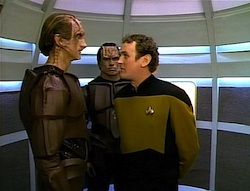“The Wounded”
Written by Stuart Charno, Sara Charno, Cy Chermak, and Jeri Taylor
Directed by Chip Chalmers
Season 4, Episode 12
Production episode 40274-186
Original air date: January 28, 1991
Stardate: 44429.6
Captain’s Log: The Enterprise is on a mapping mission near the Cardassian border. A peace treaty signed a year earlier ended the long conflict between the Federation and the Cardassians, a conflict so vicious that there’s been nothing remotely resembling an indication of it in the past three-plus seasons’ worth of television episodes. Picard reminisces about a time he faced off against Cardassians while commanding the Stargazer.
A Cardassian ship, the Trager, attacks the Enterprise without obvious provocation. The Enterprise gets the upper hand in short order, at which point the Cardassian shipmaster, Gul Macet, is willing to talk. He reveals that a Federation starship destroyed a Cardassian science station in the Cuellar system. Picard assures Macet that the Federation has no wish to abandon the treaty. Macet tartly points out that the Cardassians haven’t abandoned it, but is willing to wait an hour while Picard contacts Starfleet.
Picard talks to Admiral Haden, who reveals that the U.S.S. Phoenix, under the command of Captain Benjamin Maxwell, one of Starfleet’s finest captains, destroyed the station. Picard assumes he must have had a reason for doing so, but Haden says he’s been on silent running, so they have no frapping clue what the heck he’s thinking. The Phoenix is still in Cardassian space, and Picard needs to find him and stop him. The Cardassians allow the Enterprise safe passage through their space in exchange for Macet and two of his aides coming on board as observers.
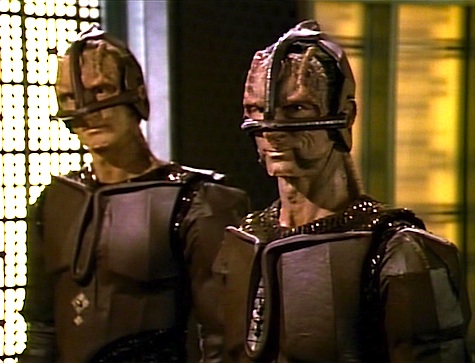
Haden also makes it clear that the Federation is in no shape for a sustained conflict right now, given the fleet’s losses at Wolf 359, and that Picard must maintain the peace at all costs.
O’Brien served with Maxwell on the Rutledge, so Picard invites him into a meeting with Macet. He reveals that Maxwell’s family was killed by Cardassian soldiers during an attack on an outpost on Setlik III. Macet assumes this to be revenge, but O’Brien disagrees.
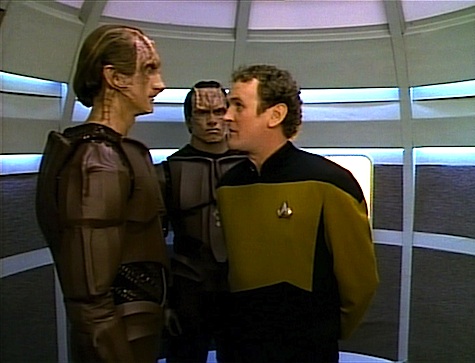
The Enterprise locates the Phoenix and sets a course. Macet tries to convince Picard to reveal their precise location and transponder code so a Cardassian ship can find them sooner rather than later, but Picard does not wish the situation to spiral out of control and declines to do so.
After refusing to drink with the Cardassians, and doing so rather obnoxiously, O’Brien goes to his quarters to prepare a potato casserole for Keiko. He sings “The Minstrel Boy,” a song he used to sing on the Rutledge while serving under Maxwell. He also insists to Keiko that he has no issue with the Cardassians, in direct contrast to the attitude he copped with them after they invited him to join them in Ten-Forward.
The Phoenix is going after a Cardassian supply ship. The Enterprise won’t get there in time, but there’s a warship nearby. Reluctantly, Picard orders Worf to supply the warship with, not only the Phoenix‘s transponder codes, but its prefix codes as well.
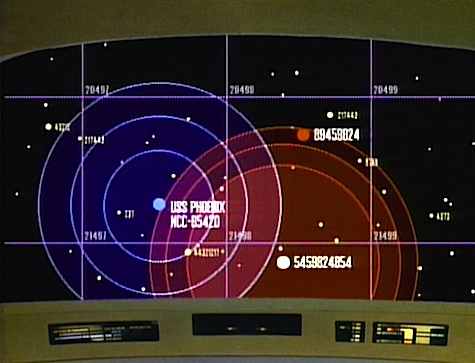
It winds up not helping, as the Phoenix destroys the warship and the supply ship. Picard inexplicably waits until after 650 Cardassians have been killed to increase to warp nine. Macet, for his part, is more than a little pissed.
Picard goes to talk to O’Brien, who sucks up (“I’ve served with the two finest captains in Starfleet”). O’Brien insists that Maxwell wouldn’t have attacked without reason, but Picard wonders if Maxwell’s anger at the Cardassians over the death of his family has become comfortable—”like old leather”—to the point where he doesn’t know how to feel any other way.
Later, O’Brien is in Ten-Forward, and decides to join Daro for that drink he offered, and apologizes for popping off at him. They talk about Setlik III. Daro says that it was a mistake: their intelligence was that it was a launching place for an attack on Cardassia. O’Brien reveals that it was on Setlik that he first killed anything, and that it isn’t the Cardassians he hates, it’s what he became because of the Cardassians.
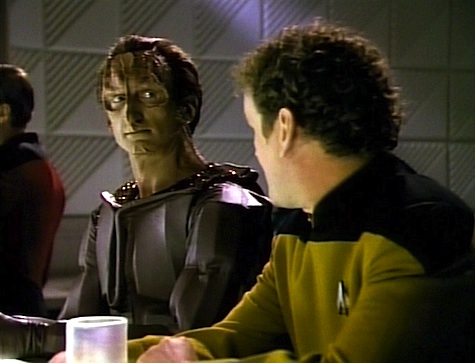
Worf brings Glinn Telle to the bridge: he was trying to access their weapons systems on a computer terminal, for which Macet upbraids him and confines him to quarters.
The Enterprise rendezvouses with the Phoenix, and Maxwell agrees to beam aboard. He and O’Brien have a brief reunion, where it’s revealed that O’Brien served at tactical on the Rutledge, then Riker escorts him to the captain’s ready room.
Maxwell informs Picard that the science station he destroyed was really a military supply outpost—but he’s weak on specifics. When Picard asks for documentation and proof, all Maxwell can come up with is that he could “smell” it. He says he didn’t report it because the bureaucrats would just sit on it for six months; they don’t know what it’s like to be under fire. Picard points out that Maxwell wasn’t under fire, and Maxwell tries some more clichés, each of which Picard has a response to. “Lives were at stake.” “Whose lives?” “We had to act now.” “Why?” “I took the initiative—I did what had to be done.” “What had to be done? For whom?”
Picard makes it clear that Maxwell’s attempts to trash the treaty are done. He will accompany the Enterprise back to Starbase 211. Picard allows him the dignity of retaining his command rather than throwing Maxwell in the brig and towing the Phoenix in disgrace.
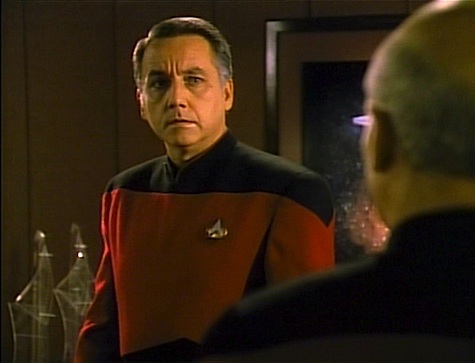
Maxwell responds to this courtesy by breaking formation and heading for a Cardassian vessel. The Enterprise pursues; at Riker’s suggestion, Picard brings O’Brien to the bridge, since he was once Maxwell’s tactical officer. The Phoenix intercepts the supply ship, but hasn’t fired yet. Data can’t read the supply ship, as it’s running with a subspace field that interferes with sensor readings.
Maxwell hails the Enterprise and insists that Picard board the ship, as it will have proof of Maxwell’s assertion that the Cardassians are re-arming. Picard refuses. Maxwell says that he’ll fire on the ship if Picard doesn’t board it; Picard counters that if Maxwell tries to do so, he’ll do whatever’s necessary to stop Maxwell.
O’Brien asks to talk to Maxwell directly. He manages to beam over and meets with Maxwell in his ready room. Maxwell asks what happened to this war, and O’Brien gently reminds him that the war’s over. But Maxwell insists that the Cardassians never stop making war, that they live for war, and refuses to accept O’Brien’s rational response that everyone thinks that about their enemy.
They reminisce about the Rutledge and wind up singing “The Minstrel Boy” together. Maxwell finally admits that he’s not going to win, and allows himself to be confined to guest quarters on the Enterprise.
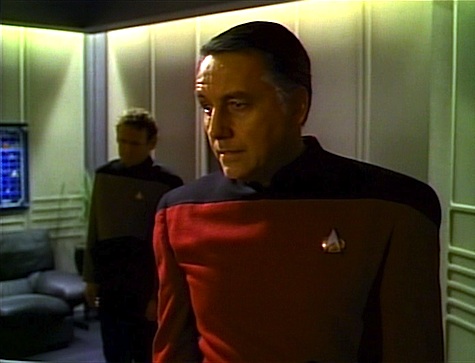
Picard has one last conversation with Macet, revealing that Maxwell was right. The station he destroyed was a weapons outpost, the supply ships were running with subspace fields to prevent their cargo being scanned. When Macet asks why Picard didn’t board the supply ship as Maxwell asked, he replies that his mission was to keep the peace. If he had boarded the ship, both sides would be arming for war, and he was trying to avoid that. But now the Federation knows what the Cardassians are up to—and they’ll be watching.
Can’t We Just Reverse the Polarity?: The Enterprise has superior sensors than Cardassian ships, as they can read their transponder codes. Macet is a little peevish when he discovers this.
The Phoenix uses a high-energy sensor system that cycles every 5.5 minutes, with a 1/50th-second window between cycles that O’Brien can punch a transporter beam through. Because he’s just that awesome.
Thank You, Counselor Obvious: Troi senses O’Brien’s hostility as soon as the Cardassians beam on board. The scene actually plays out nice and subtly, with Troi hesitating and shooting O’Brien a look, and O’Brien trying desperately to look normal and not entirely succeeding.
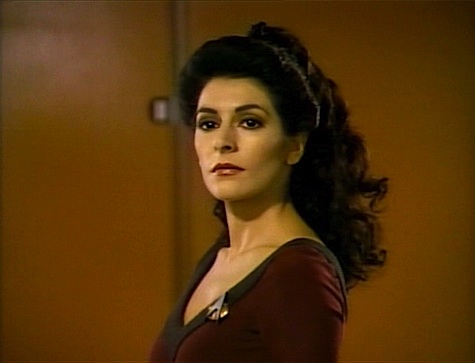
There is No Honor in Being Pummeled: Worf wants to assign a security detail to the Cardassian delegation, which Picard resists, but he does accede to his request to post guards at sensitive areas of the ship. This proves wise when Telle is caught with his fingers in the proverbial cookie jar.
No Sex, Please, We’re Starfleet: We see breakfast with the newly wedded O’Briens, as prepared by Keiko: kelp buds, plankton loaf, and sea berries. O’Brien is less than impressed (“I’m not a fish”), and offers to share some of his favorite foods with her, as she’s been doing with him, and makes her a potato casserole that evening (which she has equal trouble with—”What are these dark things?”). It plays as if this is the first time they’ve ever shared meals together, which makes you wonder what they did while they were dating. Their two scenes together feel more like early dates not long after they met, not their first week (or whatever) living together as husband and wife.
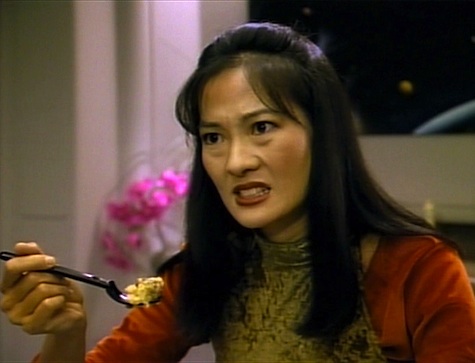
I Believe I Said That: “Benjamin Maxwell earned the loyalty of those who served with him. You know, in war, he was twice honored with the Federation’s highest citation for courage and valor, and if he could not find a role for himself in peace, we can pity him—but we shall not dismiss him.”
“You are welcome to your opinion, Captain. I, for one, am grateful that he is under lock and key.”
Picard and Macet discussing Maxwell, both making excellent points.
Welcome Aboard: Marc Alaimo makes his third appearance on TNG as Macet, having been an Antican in “Lonely Among Us” and a Romulan in “The Neutral Zone.” He’ll return as a 19th-century gambler in “Time’s Arrow Part 1,” and, of course, have a recurring role as another Cardassian, Gul Dukat, throughout Deep Space Nine.
Two other actors return, one in the same role—the late John Hancock as Admiral Haden, last seen in “The Defector“—and one as a new character—Marco Rodriguez, who played Captain Paul Rice in “The Arsenal of Freedom,” here playing Glinn Telle. Time Winters does quite well as Glinn Daro, particularly in the scene in Ten-Forward with O’Brien where they discuss Setlik III.
But the big guest here is Bob Gunton, one of the finer character actors alive, who makes Captain Maxwell far less of a caricature than he might be in the hands of a lesser talent. Probably best known for his roles in The Shawshank Redemption and on 24, Gunton currently has a recurring role as a retired general running for office on Royal Pains.
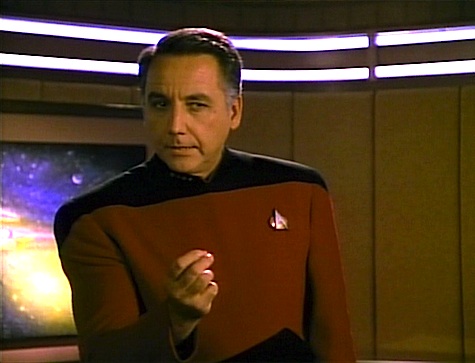
Trivial Matters: This episode introduces the Cardassians, a species that would become very important moving forward, central as they are to both Deep Space Nine and Voyager (more the former than the latter, though the Federation-Cardassian conflict is part of what sets in motion the events of Voyager‘s pilot episode).
The Setlik III massacre (and O’Brien’s participation in it) will continue to be referenced throughout DS9 (most notably in “Tribunal”), and be dramatized in the novella “The Slow Knife” by James Swallow in the Seven Deadly Sins anthology.
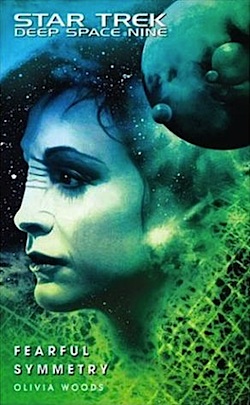
While this is the only time Macet is seen onscreen, he returns as a recurring character in the post-finale Deep Space Nine fiction, reintroduced in your humble rewatcher’s Demons of Air and Darkness and appearing in the Mission: Gamma miniseries, Unity by S.D. Perry, the Cardassia portion (written by Una McCormack) of Worlds of Deep Space Nine, and Fearful Symmetry by Olivia Woods. His resemblance to Dukat is given the in-universe explanation that they’re cousins (y’know, like The Patty Duke Show…), but he is a far more sympathetic character than the villainous Dukat.
This is the only time the brown Cardassian uniforms are seen—ditto the silly helmet Macet and the others are wearing when we first see them. The Cardassian uniform was redesigned later on to the more familiar gray uniforms seen on Deep Space Nine—including in flashbacks that predate “The Wounded.” The novel Fearful Symmetry explained that the brown uniforms were specifically for those assigned to the Federation border. (There’s no explanation for the helmet, but seriously, could there possibly be a good explanation for it?)
In addition to their development over the course of TNG and especially DS9, the Cardassian culture is also examined in depth in several novels, most notably A Stitch in Time by Andrew J. Robinson, The Never-Ending Sacrifice by Una McCormack, the three Terok Nor novels by James Swallow, S.D. Perry, and Britta Dennison, Fearful Symmetry by Olivia Woods, and your humble rewatcher’s The Art of the Impossible.
“The Minstrel Boy,” written by Thomas Moore in memory of his friends from Trinity College, Dublin who died in the Irish Rebellion of 1798, will be used again as the soundtrack music for one of O’Brien’s final scenes in the last DS9 episode “What You Leave Behind.”
Haden’s urging to Picard to keep the peace due to Starfleet’s inability to sustain a major conflict indicates that the fleet has not yet been rebuilt after the losses against the Borg in “The Best of Both Worlds Part II.” The depleted Starfleet will also be an issue in the season-spanning “Redemption” two-parter.
Speaking of “Redemption,” that episode will make use of O’Brien’s experience at tactical established here.
And speaking of the Borg attack in “The Best of Both Worlds Part II,” Maxwell specifically compliments Riker on his work against the Borg in that episode.
Make it So: “The minstrel boy to the war is gone.” This is an episode that is actually stronger upon rewatching because the Cardassians wound up becoming so important to 24th-century Trek—particularly to DS9, but also TNG and Voyager—that this episode has even greater resonance. With everything we learn about the Cardassians over the course of the next few years, Maxwell’s anger, O’Brien post-traumatic stress, and the Cardassians’ deception all feel even more compelling and convincing than it would have for a simple one-off alien empire we’ve never heard of before.
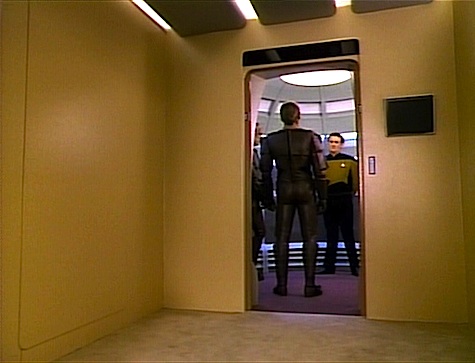
The episode also continues the expansion of the Miles O’Brien character, both in seeing his and Keiko’s new life together following their marriage in “Data’s Day,” and his past service on the Rutledge under Captain Maxwell, including fighting the Cardassians.
The Cardassians are also permitted to have depth. On the one hand, we have Telle to represent Cardassians who are less than honorable by trying to read things he shouldn’t on the computer. On the other, we have Daro and his conversation with O’Brien in Ten-Forward. And then there’s Macet. In the end, you don’t know if he’s truly as honorable as he seems when he tells Picard that he wants peace as much as Picard does, or if he’s complicit in the hiding of weapons. Or maybe both. Either way, though, his justified anger at Maxwell’s murder of almost 700 Cardassians is palpable.
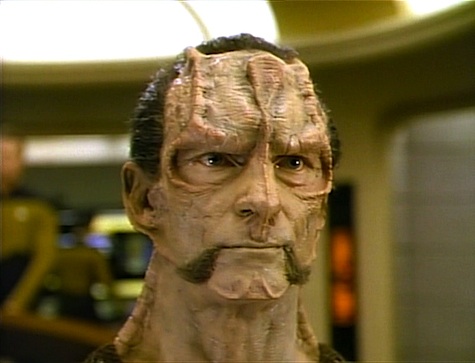
What makes the episode work most, though, is not so much the tension and the confusion and the attempts to deal with peace when you’ve gotten used to war—though that all works to some degree or other—it’s the magnificent scene in the ready room where Picard punctures the balloon of Maxwell’s macho self-righteousness. So often dramatic fiction portrays people like Maxwell as heroes, and I approve of a story in which he’s just a murdering thug. Even though Maxwell’s actually right, Picard firmly comes down on the side of the ends not justifying the means. Even O’Brien, who has trouble dealing with the Cardassians because of what he saw and did on Setlik III, knows that what Maxwell has done is wrong, pointing out the fallacy of falling for propaganda about your “war-mongering” enemies. Maxwell’s not a good person, and he deserves both the pity Picard gives him in the end, as well as Macet’s scorn.
A few things hold the episode back from being as good as it can be, and no, I’m not just talking about those awful helmets the Cardassians wore at the top of the episode. (Although, seriously, what the heck were they thinking????) First, there’s O’Brien’s remembering Setlik III, where he was escorting “women and children.” So there were no men left? What were they all doing? That just struck me as wrong, particularly in the allegedly egalitarian Federation.
Also, the peace treaty was only a year ago? So there was all this war before that, one so traumatic that it’s caused Maxwell to go all binky-bonkers? If so, well, where the heck was it during the first couple of seasons? Aside from the Borg invasion, there’s been no indication at any point on TNG that the Federation was in any kind of current armed conflict, so retconning this one strains credulity just a bit. (As a for-instance, shouldn’t it have been mentioned when Data was looking at Starfleet as a whole in “Conspiracy“?)
More fundamentally, though: where was Maxwell’s crew in all this? Their captain just committed mass murder on a major scale. If Picard did something like this, there would at least be a discussion of it—hell, the crew met to express concerns just when Picard was acting weird in “Allegiance.” But did Maxwell tell his officers that he was acting under orders? And if so, what did he tell them then the Enterprise showed up? Why did these guys all go along with the murder of 700 Cardassians?
I’m not saying it doesn’t make sense that they would go along with it, I’m saying that it’s a flaw in the story that they’re so completely absent. We don’t even see them on the Phoenix when Picard communicates with them or when O’Brien beams over.
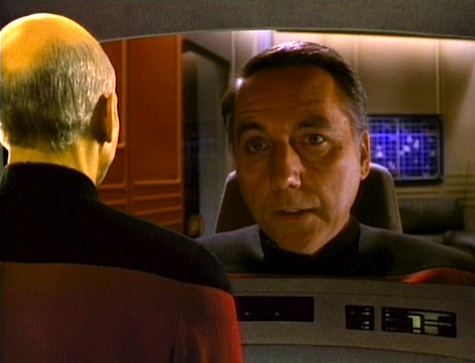
These are, admittedly, minor flaws, but they do stand out a bit, at least to me. Doesn’t mean this isn’t a good episode, though.
Warp factor rating: 7
Keith R.A. DeCandido is a guest at I-Con 31 at Stony Brook University this weekend, along with Star Trek actors Nana Visitor, J.G. Hertzler, and Casey Biggs (who played the Cardassian Damar), as well as fellow Star Trek novelists Peter David, Robert Greenberger, Glenn Hauman, John Peel, and Aaron Rosenberg. His schedule is here.










